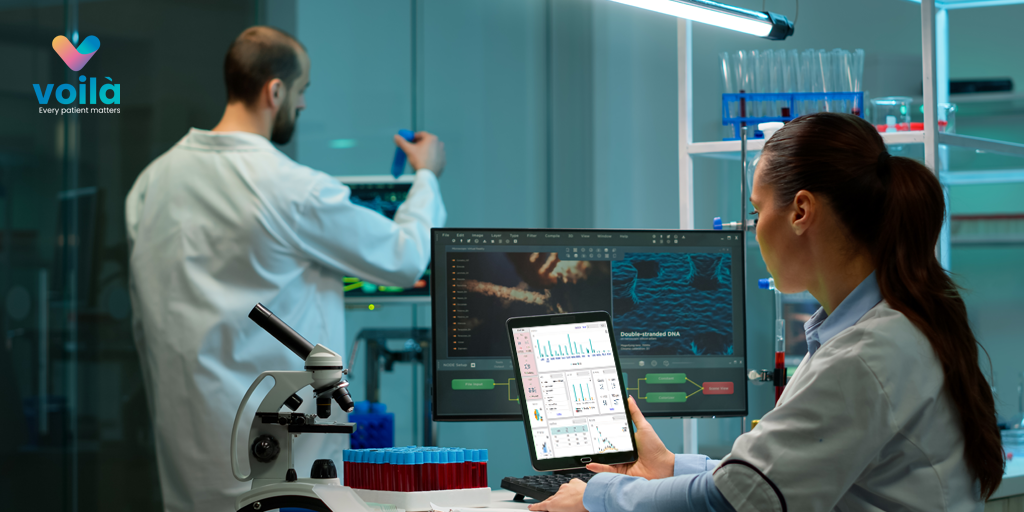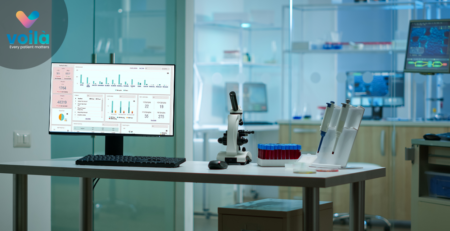Paper-based medical laboratory systems make it difficult to track samples, secure patient data, reduce the turnaround time, and share test results in real-time with physicians and patients.
Voilà’s medical laboratory information management system automates workflows and eliminates manual, repetitive tasks, saving staff time and resources. The solution permits physicians to coordinate a vast array of patient care. This ensures streamlined workflows, improved clinical outcomes, and enhanced patient satisfaction.
This article explains how the Voilà Laboratory Management Software automates medical procedures.
How Does Medical Laboratory Management Software Automate Healthcare Processes?
Medical laboratory management software ensures sample precision, productivity, and data security. Let’s discuss how this software automates various healthcare processes.
1. Sample Cataloging:
Each specimen is entered into the system as it arrives at the lab, along with information on the patient and one or more sample identifiers. Based on this sample identifier, the software assigns each pathologist a role. Over the testing process, the software securely stores all data and metadata.
2. Sample tracking:
Using system-generated barcodes, the software enables the medical/clinical laboratory to keep track of samples throughout their entire lifecycle, thereby preventing their loss or mixing
3. Instrument Integration & Management:
Medical laboratory data management software automatically uploads test results from laboratory instruments. Automation improves data integrity and efficiency. The software alerts technicians and pathologists about equipment maintenance, calibration, and other issues. It protects samples from unmaintained equipment.
4. Results reporting:
The reporting functionality and auditing tools for tests are integrated into medical lab management software. The test results are compiled and reported following current industry regulations and standards.
5. Data storage:
The test results must be stored in the patient’s electronic health records for a certain period. This ensures that healthcare professionals can always access test results. Instead of being on-premises, storage should be on a secure cloud to allow for anytime, anywhere access.
How to Choose Medical Lab Management Software that Fits Your Needs?
Selecting medical laboratory management software requires considerable study.
Choosing between a pre-built solution and a custom solution is one of the most important considerations. Pre-built software is cheaper and has standard features but may not meet your laboratory’s specific needs and processes. However, a custom-built system may fit your laboratory’s operation but cost higher. Choose configurable software that can easily adapt to laboratory workflows without expensive customization for cost-effective software.
- Due to the possibility of errors and technical issues, vendor support is also a crucial factor to consider. Timely support is necessary to ensure that operations run smoothly.
- A user-friendly interface is essential for staff to rapidly adapt to the software, as it impacts workflows and efficiency.
- Cloud-based solutions are an alternative to on-premise software, necessitating an additional hardware investment.
- The cost of medical laboratory administration software depends on features, third-party integrations, updates, and users. Cloud-based SaaS clinical laboratory management software maximizes investment returns and lowers the total cost of ownership.
Digitize your lab management process with Voilà!
As the healthcare industry digitizes, laboratories must implement digital laboratory management software to ensure efficient operations. Investing in the most effective sample management software for laboratories is prudent. Before investing in a solution, evaluating your laboratory’s needs and, if necessary, consulting with an expert is essential.
Voilà’s Lab Sample Management software automates handling samples, executing tests, providing results, and maintaining patient data. This improves efficacy and decreases clinical errors.





